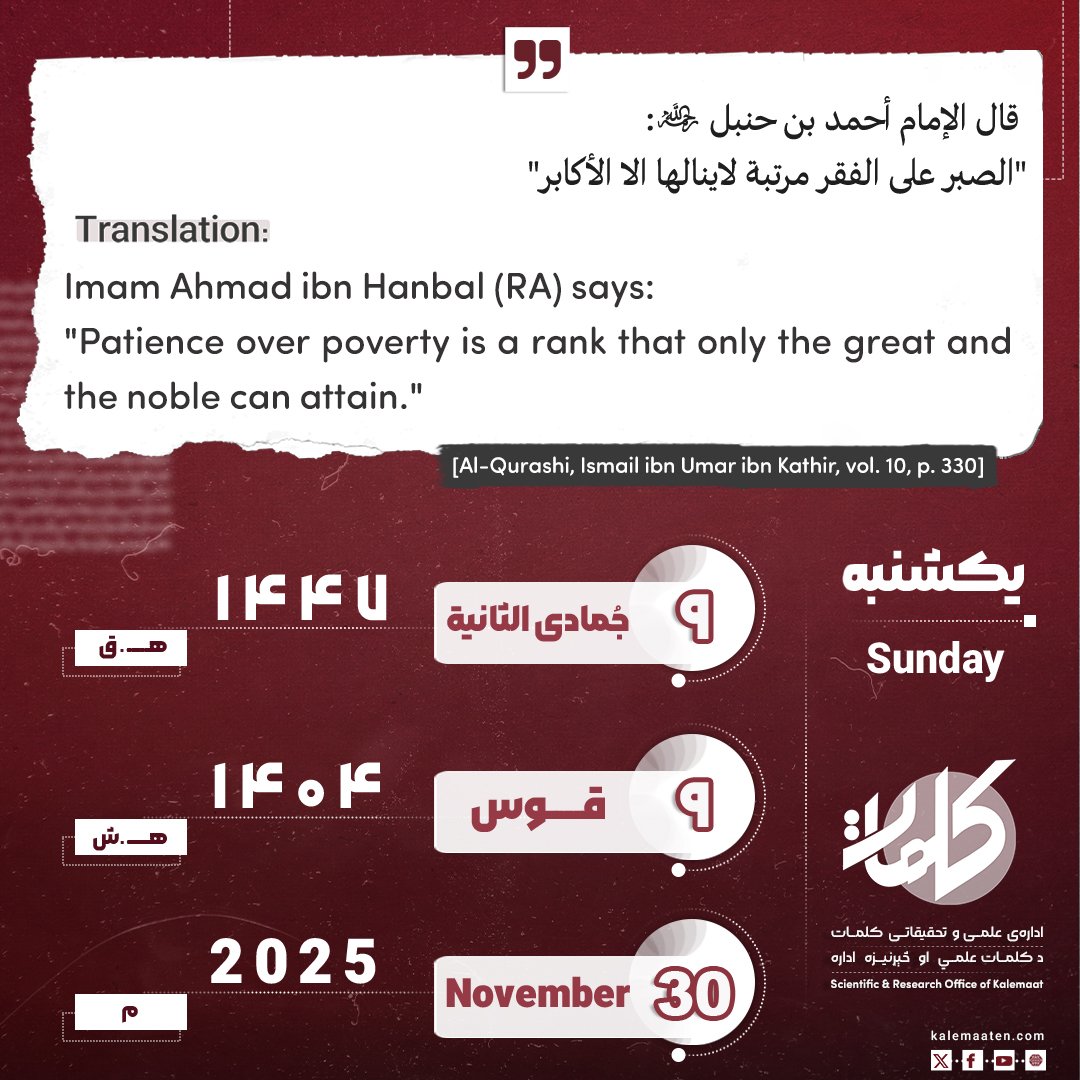Author: Mufti Obaidullah Noorzahi
The Crises of Liberalism in the Contemporary World (Part 9)
Classical Liberalism
Classical liberalism is a political tradition and a branch of liberalism that promotes the free market and laissez-faire economics — civil liberty under the rule of law, with a special emphasis on individual autonomy, limited government, economic freedom, political freedom, and freedom of expression. Its development dates back to the early 18th century and is rooted in ideas that had spread since the 13th century in the Iberian Peninsula, among the Anglo-Saxons, and in Central Europe. This ideology also had a fundamental impact on the American Revolution. [1]
Prominent figures whose ideas deeply shaped classical liberalism include John Locke, [2] Jean-Baptiste Say, Thomas Malthus, and David Ricardo. As a result of their efforts, classical liberalism aligned closely with classical economics, especially with Adam Smith’s ideas in The Wealth of Nations, as well as with the concepts of natural law,[3] social development,[4] and utilitarianism. [5] In modern times, thinkers such as Friedrich Hayek, Milton Friedman, Ludwig von Mises, Thomas Sowell, George Stigler, and Larry Arnhart are recognized as major proponents of classical liberalism. [6]
Unlike some other branches of liberalism, such as social liberalism, classical liberalism has a negative view of social policies, taxation, and government intervention in people’s lives, and it supports deregulation. [7] Until the Great Depression and the rise of social liberalism, classical liberalism was simply known as “economic liberalism.” The term classical liberalism was later introduced to distinguish the 19th-century form from social liberalism. [8]
In modern times, the term liberalism in the United States is interpreted as social liberalism, whereas in Europe and Australia, it refers to classical liberalism. [9]
In the United States, classical liberalism may be described as a combination of fiscal conservatism and social freedom. However, classical liberalism, based on its core principle of individualism, rejects both the conservative tolerance of protectionism and the social liberal focus on group rights and organized collectives.[10] In the U.S., classical liberalism is often associated with right-libertarianism. [11] In Europe, whether in its social (especially radical) or conservative forms, liberalism is considered classical liberalism and is associated with center-right economic liberalism. [12]
General Features
Classical liberalism originated in England and the Netherlands. It defended religious freedom and was inherently Protestant — but not of the rigid or fanatical kind. Rather, it allowed room for freedom of religious interpretation and considered religious wars to be foolish. It valued commerce and industry and was more inclined toward the growing middle class than the monarchy or aristocracy. It held great respect for private property rights, especially when wealth was earned through individual effort.
Although hereditary privilege was not completely rejected, its scope was significantly reduced. The notion of divine right of kings was discredited in favor of the idea that every society has the right, at least initially, to choose whatever form of government it desires. Classical liberalism implicitly leaned toward a form of democracy that recognized property rights and was thus more moderate and flexible.
It also held the belief that all people are born essentially equal, and that any later inequality is the product of circumstances. [13]
According to Bertrand Russell and Karl Marx, who were influenced by and critical of classical liberalism, this ideology played a role in the formation of their own scientific socialist philosophy.
Diverging Views
John Locke, philosopher and economist: As with other schools of thought, there is no single interpretation of liberalism. Figures like John Locke, Adam Smith, John Stuart Mill, and Montesquieu are all considered liberals, but they differ on issues such as the limits of tolerance, the legitimacy of the welfare state, and the virtues of democracy. [14]
There are also different ways to describe the emergence of liberalism. For example, Friedrich von Hayek divided it into two categories: evolutionary and rationalistic. The first developed gradually over centuries and peaked in 19th-century Britain. The second arose from the struggle of European intellectuals against clergy and feudalism. [15]
Another definition sees liberalism as the outcome of Europe’s religious wars. According to this view, the first political theories with liberal characteristics emerged in the 17th century among Protestant thinkers in Northern Europe. Their school of thought is known by various names, such as the social contract or modern natural law. Its main innovation was the effort to explain a legitimate social and political order based on a minimalist view of individual rights in a state of nature.
The state of nature is a condition in which individuals interact without being restricted or protected by society. According to this concept, people’s main concern is to preserve their life, liberty, and property from others. The liberal aspect of this theory is the idea of a natural right to freedom, which is only limited by the equal rights of others. No one is subordinate to another, and laws should impose limitations equally on all. Freedom should only be limited to the extent necessary to secure order and safety, so individuals can manage their personal affairs. [16]
Modern natural law took shape during the European religious wars and reached its height during the Thirty Years’ War (1618–1648) in Germany. During that time, the mass killing of Christians by other Christians created pressure among the warring factions to tolerate one another. The theorists of modern law were among those who advocated for tolerance. Although they cited Christian religious texts to support their views, they believed that implementing natural laws — derived through God-given reason — was in fact carrying out the will of God.
In addition to religious conflicts, the vast economic and political development of that era also contributed to the success of emerging liberal doctrines. In reality, the interests of the newly formed capitalist class, which demanded economic freedom, aligned with those of European monarchs who wanted to free themselves from the influence of feudal lords and autonomous cities.
As a result, modern states emerged. One of the shared features between modern natural law doctrines and these modern states was that neither accepted intermediaries between the state and its citizens. In other words, on one side stood the state, and on the other, individuals equally subject to the political community. [17]
Continues…
Previous Part
References:
[1]. An Introduction to Government and Politics: A Conceptual Approach, p. 129; What Is Classical Liberal History?
[2]. The Unvarnished Doctrine: Locke, Liberalism, and the American Revolution
[3]. Liberalism and Republicanism in the Historical Imagination, p. 54
[4]. Property and Prophets: The Evolution of Economic Institutions and Ideologies, p. 54
[5]. Handbook of Political Theory, p. 422
[6]. Darwinian Evolution and Classical Liberalism: Theories in Tension, p. 13
[7]. Ibid.
[8]. An Introduction to Government and Politics: A Conceptual Approach, p. 129
[9]. Contending Liberalisms in World Politics: Ideology and Power, p. 52
[10]. The danger of confusing liberals and leftists, Sep. 12, 2019
[11]. Liberal? Are we talking about the same thing?, July 20, 2010
[12]. Goodman, John C. (Jan. 2, 2022). Classical Liberalism vs. Modern Liberalism and Modern Conservatism
[13]. Klein, Daniel B. (May 3, 2017). Libertarianism and Classical Liberalism: A Short Introduction; Bertrand Russell, History of Western Philosophy, trans. Najaf Daryabandari
[14]. Ryan, Liberalism, A Companion to Contemporary Political Philosophy, p. 360
[15]. Galston, Liberalism, The Encyclopedia of Political Thought
[16]. Charvet, Liberal Theories, Liberalism: The Basics, pp. 137–139
[17]. Charvet, Liberal Theories, Liberalism: The Basics, pp. 139–140



